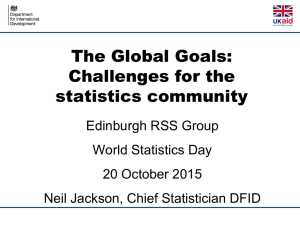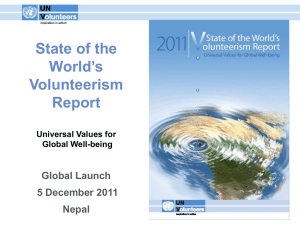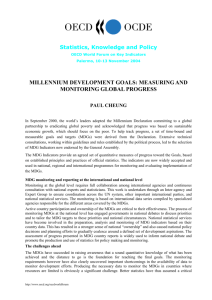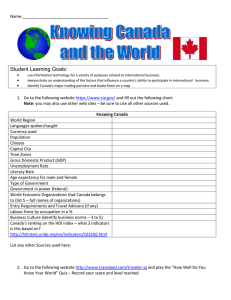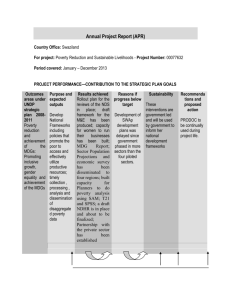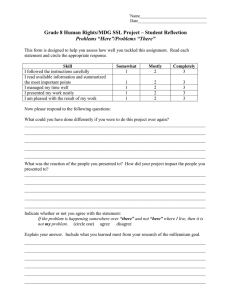LEARNING FROM NATIONAL MDG REPORTS Open Working Group, New York December 2013
advertisement
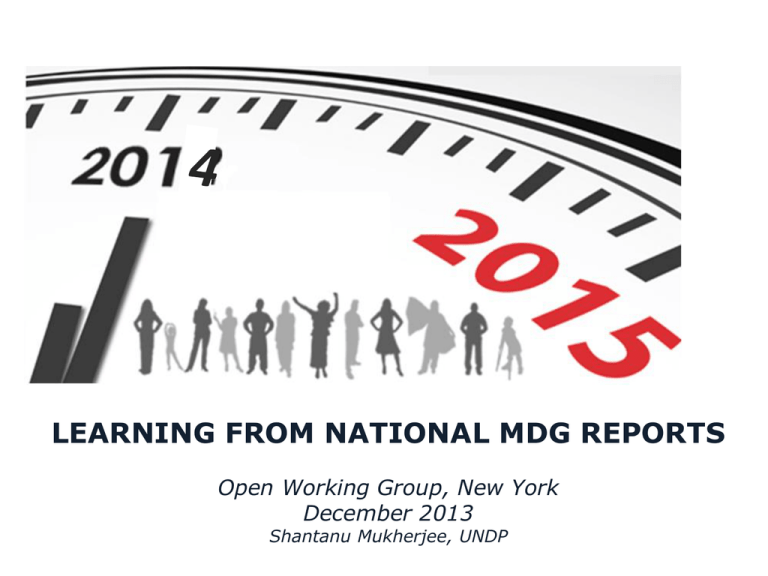
LEARNING FROM NATIONAL MDG REPORTS Open Working Group, New York December 2013 Shantanu Mukherjee, UNDP THE MONITORING FRAMEWORK FOR THE MDGs • Timeline – – 2000, Millennium Declaration (MD) – 2001, Roadmap towards the implementation of the MD – 2007, Revised monitoring framework from 2005 World Summit • Four new targets • Currently – Eight goals, 21 targets, 60 indicators • Goals 1-7 cover 15 targets, 44 indicators GLOBAL AND NATIONAL MONITORING • Differences in objectives – Globally • Comparable across countries; set incentives for national action; used for regional and global aggregates – Nationally • Advocacy and national ownership; policy design; challenges in country context; empowerment at UN debates and negotiations • Differences in mechanisms – Inter-Agency Expert Group • Annual reports – UNDP - scorekeeper of the MDGs at national level • Over 400 national MDG reports – government owned • Guidance for countries (2001, 2003, 2009, 2013, 2015) • Available information/data for emerging priorities, estimates for 2015 as baselines for next agenda ACROSS REGIONS AND TYPOLOGIES GOALS, TARGETS AND INDICATORS • Goal – Ambitious, specific commitment; operational and easy to communicate • Targets – Quantified, time-bound outcome contributing to achievement of the goal – Can be global or national • Indicators – Quantified, objectively measurable metric (s) that can be used to assess – Progress towards the goal (outcome) – Express different dimensions of the goal – Intermediate steps that are expected to contribute significantly to progress – Obtained from different sources – surveys, administrative data, model estimates EXAMPLE 1 – MDG 1 • Goal – Eradicate extreme poverty and hunger • Targets – – Global – Halve, between 1990 and 2015 the proportion of people whose income is less than one dollar a day – National – ‘Reduce, from 20.4 to 8.8%, the proportion of people living in extreme poverty’ (Colombia) • Indicators – – Progress towards the goal (outcome) • Proportion below the poverty line – global, national – Express different dimensions of the goal • Inequality – share of poorest quintile in national consumption – Intermediate steps that are expected to contribute significantly to progress – Obtained from different sources – surveys, administrative data, model estimates EXAMPLE 2 – MDG 5 • Goal – Improve maternal health • Targets – – Global – • Reduce, by ¾ between 1990-2015, the maternal mortality ratio • Achieve, by 2015, universal access to maternal health – National – ‘By 2015, maintain the fertility rate at current levels, reduce the abortion rate by half and double the proportion of women using modern contraceptive methods’ (Serbia) • Indicators – – Progress towards the goal (outcome) • Maternal mortality ratio – Express different dimensions of the goal • Antenatal care coverage • Adolescent birth rate – Intermediate steps that are expected to contribute significantly to progress • Proportion of births attended by skilled health personnel – Obtained from different sources – surveys, administrative data, model estimates REPORTING VARIES BY INDICATOR Trends in reporting for goal 5 140 120 Total Countries Reporting 100 80 Target 5.A - MMR Target 5.B - Reproductive health 60 Total number of countries 40 20 0 2001 2002 2003 2004 2005 2006 2007 2008 2009 2010 2011 2012 Year Source: Own calculations based on developing countries’ national MDG reports at http://www.undp.org/content/undp/en/home/librarypage/mdg/mdg-reports/ NATIONAL ADAPTATION CONSIDERABLE Source: Own calculations based on countries’ national MDG reports at http://www.undp.org/content/undp/en/home/librarypage/mdg/mdg-reports/ CHANGING TARGETS, ADDING GOALS AND INDICATORS MDG 2 ‘Ensure that, by 2015, children everywhere, boys and girls alike, will be able to complete a full course of preschool and high school’ (Morocco) MDG 3 ‘Ensure that, by 2015, at least 50% women in economically active workforce’ (Tajikistan) MDG 4 ‘Reduce by half, between 2005 and 2015, the under-5 mortality rate in highland areas and selected northern and three southernmost provinces’ (Thailand) MDG 6 ‘Achieve by 2015, universal access to treatment and prevention of NCDs and control of major risk factors - smoking, alcohol use, obesity, physical activity, kava, by gender’ (Vanuatu) MDG 7 ‘Increase waste recycling ratio to 75%’ (Saudi Arabia) ‘MDG 9’ ‘Zero impact of landmines and explosive remnants of war (ERW) by 2012’ (Cambodia) DISAGGREGATING TO SUB-NATIONAL LEVELS • Initially – rural/urban, but increasingly by territory – 2001-2005: 23% – 2006-2010: 33% – 30 countries more than once – including CAR, Congo, Djibouti as well as a number of MICs • Most frequent – Poverty, Hunger, Education, Child Mortality, Maternal Mortality, Water and Sanitation • Least frequent – Reproductive health, environment • Philippines, Indonesia, Colombia and some others also disaggregated goals and targets by region GUIDING POLICY THROUGH ADMIN DATA Source – ‘Accelerating progress, sustaining results: the MDGs to 2015 and beyond’, UNDP, 2013. THINKING AHEAD… • National priorities already being set (UNDP survey and 2013-2015 national MDG reports- ongoing) – – • Balancing national and global agendas – – • Indicators can motivate action (e.g. efficiency of water use in agriculture) How to encourage universal reporting on such indicators? Administrative data covers a spectrum – – • Eradicating poverty or universal school attendance What are cost-effective methods for monitoring progress, globally and nationally Targets could involve the need to balance trade-offs within and across goals – – • MDG model for adaptation was laissez faire – but allowed national adaptation and global reporting Transitioning from global to national could need guidance – what targets could need this? More universal targets likely – – • Vision statements, perspective plans: several anticipate items likely to feature in future agenda What are the data needs for supporting them? Process versus outcome indicators – how certain are the theories of change? What are good criteria for their use? -mapping, defining and increasing reliability and objectivity Using and validating data linked to new technology – – Pace of change has increased, as has demand for more timely data; GIS, internet, mobile phones How best does ‘big’ data complement ‘small’ data?
